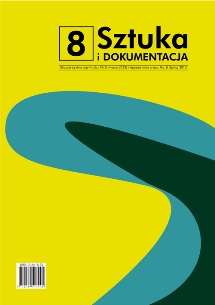Marginesy, minima, media, itp. O politycznym znaczeniu sztuki konceptualnej
Margins, Minima, Media etc. The Political Meaning of Conceptual Art
Author(s): Leszek BrogowskiSubject(s): Fine Arts / Performing Arts
Published by: Akademia Sztuk Pięknych w Gdańsku
Keywords: sztuka konceptualna; polityka; sztuka polityczna; marginesy kultury; kultura alternatywna; przestrzeń społeczna; krytyczna swiadomość; fotografia; minimalizm; mass media; nominalizm
Summary/Abstract: This article focuses upon the issue of the political meaning of art. It discusses the possibility of making art political. It also attempts to define the ways in which political art functions and points out two ways: as undertaking a political topic or as a form which adopts a political meaning. The research field of the article is the period 1960-1980 when art was especially political, and conceptual art in particular. Even though conceptual art fairly rarely refers directly to politics, its political content has a deeper, philosophical character. The article concentrates on the following aspects of art from the period 1960-1980: 1. The choice of the artist to occupy a position on the margin of society, contradicting the myth of the artist-genius, surrounded by glory, success and the recognition of society 2. The stance of the artist as the organiser of “artistic life”: galleries, archives, festivals, exhibitions, etc. 3. The concept of art as a specific kind of research on reality, which would then allow art to be properly placed within a university structure and treat the teaching of it as a form of an artistic practice. 4. The analytic tendency to research media used by art. 5. Problematic issues relating to the body, which, contrary to dominating models, is present in many conceptual art projects. 6. The self-reflective stance of the artist towards art, a stance that aims to criticise the term and to confront the social artistic practice, which was a feature of artistic conflict during the period 1960-1980. The conclusion points out one particular and at the same time, typical form of conceptual art which was the artist’s book. This kind of book is political by its form and is an example of making discourse political by the way art acts, not necessarily by undertaking a political discussion.
Journal: Sztuka i Dokumentacja
- Issue Year: 2013
- Issue No: 8
- Page Range: 9-19
- Page Count: 11
- Language: Polish

